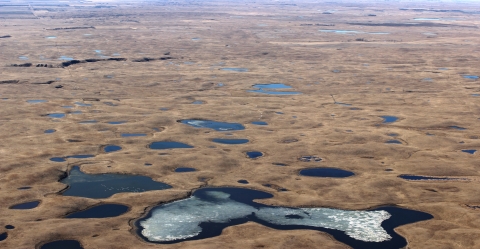About Us
The Kulm Wetland Management District was established in July 1971. It is located in the Prairie Pothole Region of North America--a grassland landscape formed by glaciers and marked by numerous wetlands called potholes. This area extends from Canada and down through Montana, the Dakotas, Minnesota, and into northern Iowa. This area is sometimes referred to as "the Duck Factory" because over half of the continent's waterfowl are hatched and raised here. It provides the most productive breeding habitat in North America for hundreds of ducks, geese, and other migratory bird species.
The District conserves wetlands and grasslands in Dickey, LaMoure, Logan, and McIntosh counties for waterfowl and other wildlife species. The District is comprised of Waterfowl Production Areas, limited-interest National Wildlife Refuges, and wetland and grassland easements. Some of the focal species in the District are mallard, blue-winged teal, sedge wrens, upland sandpipers, black terns, and northern harriers.
Our Mission
Each unit of the National Wildlife Refuge System is established to serve a statutory purpose that targets the conservation of native species dependent on its lands and waters. All activities on those acres are reviewed for compatibility with this statutory purpose.
The mission of the U.S. Fish and Wildlife Service is working with others to conserve, protect, and enhance fish, wildlife, and plants and their habitats for the continuing benefit of the American people.
The Kulm Wetland Management District purpose is "to assure the long-term viability of the breeding waterfowl population and production through the acquisition and management of waterfowl production areas, while considering the needs of other migratory birds, threatened and endangered species, and other wildlife.
The Kulm Wetland Management District was formed with four main objectives:
- wetland preservation
- waterfowl and wildlife production
- maintenance of breeding grounds for migratory birds
- to provide a northern staging area and habitat for bird migration
Our History
Kulm Wetland Management District was established through the Fish and Wildlife Coordination Act (16 USC 664). Such areas...“shall be administered by [Secretary of the Interior] directly or in accordance with cooperative agreements… and in accordance with such rules and regulations for the conservation, maintenance, and management of wildlife, resources thereof, and its habitat thereon.”
District lands provide food, water, shelter and space for a variety of wildlife species. We focus our efforts on managing the land to meet the needs of waterfowl and other migratory birds, threatened and endangered species, and resident wildlife.
In August 1958, Congress passed Public Law 85-585 which amended the Migratory Bird Hunting and Conservation Stamp Act of 1934 (the Duck Stamp Act). This amendment authorized the U.S. Fish and Wildlife Service Small Wetland Acquisition Program. This program was started to save wetlands from various threats, particularly drainage. This allowed for the acquisition of waterfowl production areas and easements.
The first waterfowl production area waterfowl production area
Waterfowl production areas are small natural wetlands and grasslands within the National Wildlife Refuge System that provide breeding, resting and nesting habitat for millions of waterfowl, shorebirds, grassland birds and other wildlife. Virtually all waterfowl production areas are in the Prairie Pothole Region states of Iowa, Minnesota, Montana, North Dakota and South Dakota.
Learn more about waterfowl production area in the District was purchased in LaMoure County on May 5th, 1960. In July of 1971, the Kulm Wetland Management District was officially established. The new District was created by transferring Logan and McIntosh counties from Slade Wetland Management District and Dickey and LaMoure counties from Tewaukon Wetland Management District. These four counties in southeastern North Dakota still make up the District.
Today, the District protects over 280,000 acres of grasslands and wetlands:
- Waterfowl Production Areas: 200 units totaling 45,378 acres
- Wetland easements: over 2,000 contracts protecting over 140,000 wetland acres
- Grassland easements: over 280 contracts protecting over 90,000 grassland acres
- Three Easement and small fee National Wildlife Refuges totaling 4,152 acres
- Farmers Home Administration (FmHA) conservation easements: 27 contracts protecting 4,130 acres

